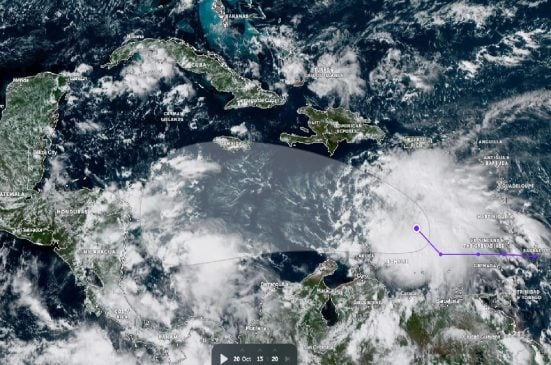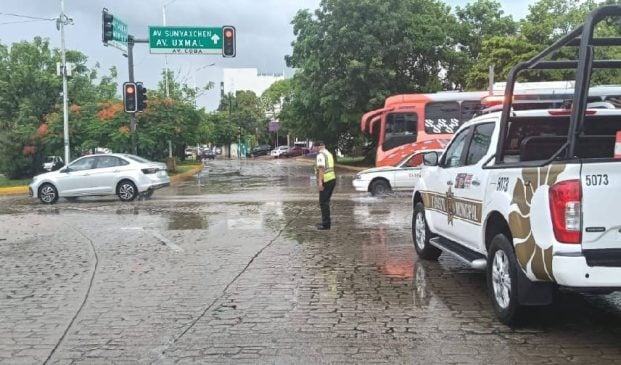Riviera Maya, Q.R. — AccuWeather expert meteorologists are sounding the alarm about the growing threat of flooding rainfall, damaging winds, and dangerous storm surge in Texas from Beryl.
The team at AccuWeather’s Global Weather Center is forecasting Beryl to make landfall in southern Texas as a Category 1 hurricane Monday morning with maximum sustained winds of 74-95 miles per hour on the Saffir-Simpson Hurricane Wind Scale.
AccuWeather meteorologists warn that any wobbles with the center of the storm, and the possibility that the storm may try to turn to the north upon nearing the coast at the last minute, could push landfall significantly farther to the north in Texas.
“As Beryl approaches the Texas coast on Sunday, a dip in the jet stream will act like a magnet and pull the storm more to the north and northwest. Right now, we’re expecting Beryl to make landfall near Corpus Christi as a Category 1 hurricane,” said AccuWeather Chief On-Air Meteorologist Bernie Rayno.
“We expect Beryl to slow down as it approaches the Texas coast, and that could cause some big flooding problems.”
The anticipated slower forward speed will increase the duration of wind, pounding surf and storm surge in northeastern Mexico and a large part of the Texas coast.
Rainfall from Beryl is expected to arrive in Texas on Sunday. AccuWeather expert meteorologists say 8-12 inches of rainfall is expected along the southern Texas coast and across parts of central and southeast Texas. The hardest-hit areas of Texas could have up to 24 inches of total rainfall, according to the AccuWeather Local StormMax™.
“If that rain comes too fast and too furious, significant and life-threatening flooding can occur. We’ve seen it before with hurricanes in Texas,” said AccuWeather Chief Meteorologist Jon Porter.
“Whenever you have a tropical storm or hurricane slowing down, that is a huge red flag for AccuWeather meteorologists because we’re talking about the storm bringing in copious amounts of tropical moisture and the risk for persistent downpours over the same areas which can lead to major flooding in the hardest hit areas.”
Beryl could push 3-6 feet of storm surge into coastal areas along the southern Texas coastline. AccuWeather expert meteorologists say 1-3 feet of storm surge is possible far north as Galveston Bay.
Swells from Beryl are expected to create dangerous rip currents and rough surf along Texas beaches today through next Tuesday. The risk of rip currents could stretch across the entire U.S. Gulf Coast this weekend, creating beach hazards as far away as southwest Florida.
“With so many people that are going to be in the water along the Gulf of Mexico this weekend, the impacts from Beryl can be far-reaching. We’ve seen that with other hurricanes in years past that have tragically taken many lives in the surf zone due to rip currents, occurring under blue skies hundreds of miles away from the storm,” said Porter.
“The rip current risk is real and it could be a dangerous weekend in some areas considering many people will be in the water on a hot, holiday weekend along the Gulf Coast. Be aware of that risk, follow the direction of local officials and lifeguards, and know how to react if you encounter a rip current at the beach.”
AccuWeather expert meteorologists say strong winds from Beryl are expected to arrive in southern Texas later Sunday, then spread up the coast through Sunday night.
AccuWeather expert meteorologists say they cannot rule out the possibility that Beryl could strengthen to a Category 2 hurricane before making landfall, with maximum sustained winds of 96-110 mph on the Saffir-Simpson Hurricane Wind Scale.
Beryl shattered records earlier this week as the earliest Category 5 hurricane to form in the Atlantic basin, causing catastrophic damage and claiming several lives when it blasted through the Windward Islands.
Beryl made landfall near the town of Tulum Friday as a category 2. According to the NOAA, there is currently a hurricane watch in effect for the Texas coast from Baffin Bay northward to Sargent.


